|
Related FAQs: Wrasses In
General, Wrasses, Wrasse Selection, Wrasse Compatibility, Wrasse Feeding, Wrasse Diseases,
Related Articles: Wrasses, Anampses, Hogfishes/Bodianus, Maori Wrasses/Cheilinus &
Oxycheilinus, Fairy/Velvet
Wrasses/Cirrhilabrus, Coris
& Coris gaimard, Bird Wrasses/Gomphosus, Halichoeres, Cleaner Wrasses/Labroides, Tubelip Wrasses/Labropsis,
Leopard
Wrasses/Macropharyngodon, Pencil
Wrasses/Pseudojuloides, Razorfishes, Pseudocheilinus, Stethojulis, Thalassoma
Over to other Regional Accounts of
Wrasses:
To: A Fishwatcher's
Guide to the Fishes of the Cook Islands
The Conscientious Marine
Aquarist
Wrasses of
the Cook Islands
Part II of
three
To Parts I, III
|
|
| Bob Fenner |
|
|
The Pacific Bird Wrasse, Gomphosus
varius, I've never seen look better from anywhere. The males
here are spectacularly colored and seemingly friendlier than
Gomphosus everywhere else I've been.
|
|
Gomphosus varius Lacepede 1801, is the much
more common Bird Wrasse (1) in the west. Its males are lighter
green over-all, and females transversely white to black front to
back, with an orangish upper "beak". The common Bird
Wrasse is found in Hawai'i to the tropical western Pacific
and eastern Indian Ocean. Female in Hawai'i, male in the
Cooks.
|
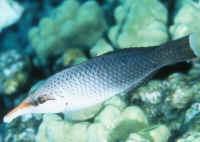 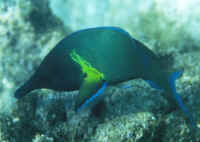 |
|
Genus Epibulus: The Sling-Jaw Wrasse,
Epibulus insidiator (Pallas, 1770) is showing up more and
more in the industry, and is a real winner looks-wise, though
I'll still have to rate it a moderate score (2) in historical
hardiness. Females are golden yellow over-all, while males are
blackish in the back, pale on the face, with an orange-brown
"coat" on their back.
|
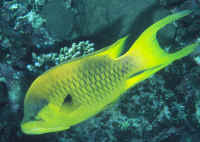 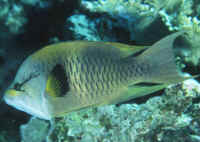
|
|
The huge genus Halichoeres, the Rock Wrasses, have five
species in the Cooks. Halichoeres hortulanus, the
Checkerboard Wrasse, Halichoeres margaritaceus, the
Pink-belly Wrasse, Halichoeres melasmapomus, the Cheekspot
Wrasse, Halichoeres melasmapomus, the Cheekspot Wrasse,
Halichoeres ornatissimus, one of the three "
Christmas Wrasses", aka the Ornate Wrasse to science, and
Halichoeres trimaculatus, the Three-spot Wrasse could all
be used in the ornamental interest, though only the first and
fourth are currently.
|
|
Halichoeres hortulanus (Lacepede 1801), the
Checkerboard Wrasse (2), comes in two varieties, the more common
one from the Pacific and a more colorful color morph in the
Indian Ocean into the Red Sea. Pictured: A juvenile of about two
inches length, and a "pair" in the Maldives. A larger
Halichoeres at ten or so inches in an aquarium..
|
| Halichoeres margaritaceus (Valenciennes
1839), the Pink-belly Wrasse. Indo-Pacific. To five inches in
length. Fiji and aquarium images. |
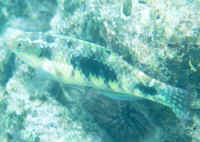 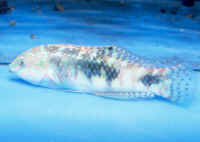
|
| Halichoeres melasmapomus Randall 1981, the
Cheekspot Wrasse. Indo-West Pacific. To ten inches total length.
Occasionally shows up in our interest, often sold as a
"miscellaneous" wrasse. This juvenile photographed in the
Cook Islands. |
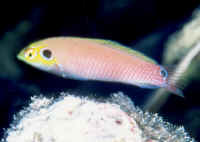
|
|
Halichoeres ornatissimus (Garrett 1863) is
(one of) the three " Christmas Wrasses" (2), aka the
Ornate Wrasse to science. This can be a very hardy fish should
you secure an initially healthy specimen. Unfortunately, way to
many are doomed from the trauma of rough handling through the
collection process. To six inches. Aquarium photo. Indo-Pacific
to Hawai'i, where it is best imported from.
|
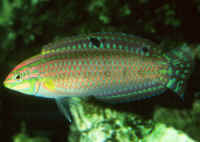
|
| Halichoeres trimaculatus (Quoy & Gaimard
1824), the Three-spot Wrasse. Indo-Pacific. To eleven inches in
length. Adults in the Cook Islands and Fiji. This species used as
food and occasionally in the aquarium trade. |
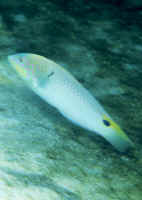 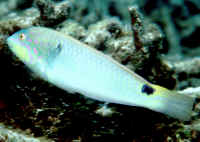
|
|
Genera Hemigymnus and
Hologymnosus. Way too often I see the Barred
Thicklip (Hemigymnus fasciatus, Ring and Pastel
Ringwrasses, (Hologymnosus annulatus and H.
doliatus) offered to hobbyists as juveniles. They shouldn't
be. All are too touchy and get too large to be aquarium
specimens
|
|
Hemigymnus fasciatus (Bloch 1792), the
Barred Thicklip Wrasse (2). Indo-Pacific, including the Red Sea,
east to Tahiti. To thirty two inches long in the wild. Pictured
are a six inch juvenile in an aquarium, Fiji, and a two foot
adult in the Maldives.
|
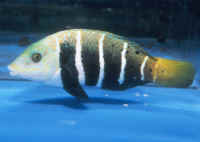 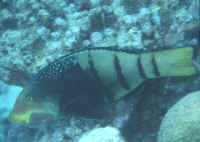 |
|
Hologymnosus annulatus (Lacepede 1801), the
Ring Wrasse (2). Indo-Pacific, including the Red Sea east to the
Marianas. To sixteen inches in length. Here are images of a
juvenile (3"), female and male in the Red Sea.
|
| Hologymnosus doliatus (Lacepede 1801), the
Pastel Ring or Candycane Wrasse (2). Indo-Pacific east to the Line
Islands. To eighteen inches. Images: juveniles and adult female in
an aquarium. |
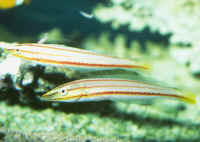 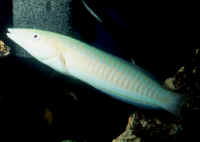
|
|
Three species of Labroides Cleaner
Wrasses call the Cooks home. The too-popular common Bluestreak
(L. dimidiatus), the Bicolor (L. bicolor) and
Redlip (L. rubrolabiatus)? all have dismal survival
histories in captivity and are needed to do their ?barbering? in
the wild. Leave them there.
|
|
Labroides bicolor Fowler & Bean 1928,
the Bicolor Cleaner Wrasse (3), easily recognized, easily lost
Indo Pacific beauty. Indo-Pacific, east Africa to Micronesia. To
five and a half inches in length. Here are images of a juvenile
and adult in Maldives and Fiji respectively.
|
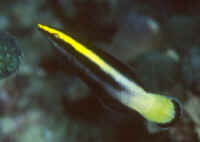 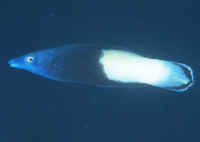
|
|
Labroides dimidiatus (Valenciennes 1839),
the common or Blue Cleaner Wrasse (3). Thousands will be
collected today and thousands will die. One out of thousands
lives for a year in captivity. Indo-Pacific, east Africa, Red Sea
to the Marquesas. To four and a half inches in length. Juvenile
in Bunaken/Sulawesi/Indonesia. Adult, for a short while, in
captivity.
|
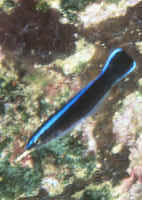 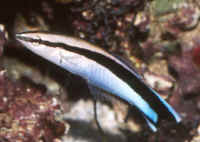
|
|
Labroides rubrolabiatus Randall 1958, the
Red Lip Cleaner Wrasse (3), of the Pacific's Oceania ought to
be left in the sea as well. To four inches in length. On a Moray
Eel (Gymnothorax javanicus) in Moorea, French Polynesia
and in Fiji.
|
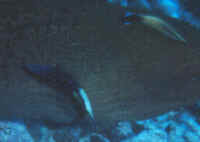 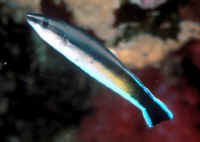
|
|
Labropsis. The Tube-Lip
Wrasse, Labropsis polynesica Randall 1981 is reported from
here as part of its Eastern Central Pacific range.
|
|
Genus Macropharyngodon.
Two Leopard Wrasse species are found here. The most commonly
offered member of the genus, the Blackspotted Macropharyngodon
meleagris and less often seen Yellowspotted M.
negrosensis. These fishes rarely live for any time in
captivity.
|
|
Macropharyngodon meleagris (Valenciennes
1839), the most common species offered in this genus to the
aquarium trade, is either THE Leopard or Guinea Fowl Leopard
Wrasse (3). Indo-Pacific; Cocos Keeling to the Western Pacific.
To six inches in length. Aquarium image.
|
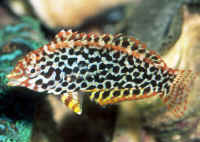
|
|
Macropharyngodon negrosensis Herre 1932, the
Black Leopard Wrasse (3) is usually offered as a
"miscellaneous" item. Only the ones from Australia
generally live. Indo-Pacific; Andaman Sea to Samoa. To nearly
five inches in length. Aquarium and Redang, Malaysia images.
|
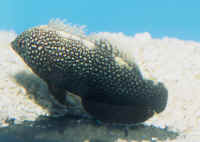 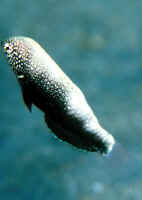
|
|
Razorfishes. The Rock Mover, aka the
Dragon Wrasse, Novaculichthys taeniourus is found here in
good numbers, all good-sized adults that I've seen. Definitely
not ?reef-safe? this fish can be too rambunctious for any but the
most rough and tumble fish tankmates. Another Razorfish from here
is Cymolutes praetextatus, the Knife Razorfish.
|
|
Novaculichthys
taeniourus (Lay & Bennett 1839) the Rock Mover,
Dragon or Indian Wrasse (2) is a very hardy fish that is more
often killed by aquarists than dies from other influences. As an
aquarium specimen this species requires regular "beefy"
feedings of animal-based foods. It is a gluttonous feeder that
quickly starves if underfed. Not for reef tanks, Razorfishes are
territorial and aggressive fishes. To about a foot in
length. Juvenile in captivity and adult in Hawai'i
shown. One other species in this genus. Not used in the
trade.
|
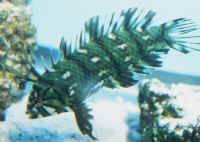
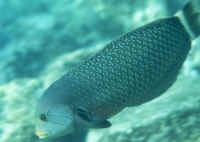
|
To Parts I, III
|
|

